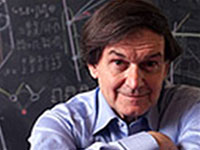Quantum consciousness
 In Mapping The Mind, the book I reviewed here earlier, the author gives Sir Roger Penrose a page to describe his theory of quantum consciousness, based on “tubules” within brain cells:
In Mapping The Mind, the book I reviewed here earlier, the author gives Sir Roger Penrose a page to describe his theory of quantum consciousness, based on “tubules” within brain cells:
The human body contains structures called microtubules—tiny tubes that are especially prevalent in nerve cells. Those in brain cells could, I propose, give rise to a stable quantum state that would bind the activity of brain cells throughout the cerebrum and in doing so give rise to consciousness. Such a state could not be replicated in a computer…I have a strong feeling that it is obvious that the conscious mind cannot work like a computer.
Penrose’s thesis is set out most clearly in his book Shadows of the Mind: A Search for the Missing Science of Conscousness . Perusing the reader reviews on Amazon, the one that stuck in my mind accused Penrose of an elementary syllogistic error: “the mind is strange, quantum things are strange, therefore the mind is quantum.” Another asks why tubules in cells in the foot do not generate consciousness.
I would add that the brain not being computer-like, an assertion with which I agree, does not imply that the brain uses some particular mechanism just because it is also not computer-like. Overall, though, I am not qualified to pass judgment on Penfield’s theories, even if I had read his books, which I haven’t. But given our lack of progress in understanding consciousness it certainly seems worthwhile to keep an open mind. And quantum consciousness certainly, in theory, could explain phenomena that more physicalist approaches could not.
Penrose’s collaborator in this consciousness research is Stuart Hameroff. By coincidence I just happened to run across an interview with him on the The Holy Grail, an offbeat blog worth reading if you’re interested in pyramids, life after death, and that sort of thing. Excerpt:
The Penrose-Hameroff quantum consciousness hypothesis proposes that quantum computations in microtubules inside the brain’s neurons convert pre/subconscious possibilities (manifest as dream-like quantum information) to particular information (choices, perceptions) by a type of quantum state reduction, or collapse of the wave function. The reduction itself – an instantaneous event connected to the funda-mental level of reality, as suggested by Penrose – is a conscious moment. A sequence of such moments gives our stream of consciousness.

May 6th, 2005 at 03:48
I laughed out loud at “I have a strong feeling that it is obvious” as a form of argument from Penrose. I’ve read his “Emperors new mind” and was not impressed. That phrase more or less sums up his argument – – he just feels strongly.
Penrose speaks of “like a computer”, and you also use the term “computer-like”. This doesn’t mean much unless we define “like in what sense”.
This is my first visit to your site, so my apologies if this definition is covered somewhere else here.
October 30th, 2008 at 16:28
I think matter springs from consciousness and not the other way round (the vedantic view). Bishop Berkely said there was no reason to postulate matter: it is made of spirit. When you dream you have no problem (after you wake up) in postulating that the body you had in your dream (and the bodies everyone else had in the dream) are made of consciousness. That is not to say it is unreal – at the time it is very real. Consciousness is very real, as real as matter could ever be. Waking life is longer-lasting and more consistent than a dream. The riddle becomes entrenched by the tandem nature of conscious experience and brain activity: but when you examine someone else’s brain and listen to what they say, see the tandem dance and conclude that one comes out of the other, you may still be on the wrong track. Consciousness is the ULTIMATE RIDDLE. In an epiphenomenal physical world consciousness would be completely superfluous.
October 30th, 2008 at 16:35
I should proof-read before I post! Berkeley! First sentence should read ‘I think matter springs from consciousness (the Vedantic view) and not the other way round.’